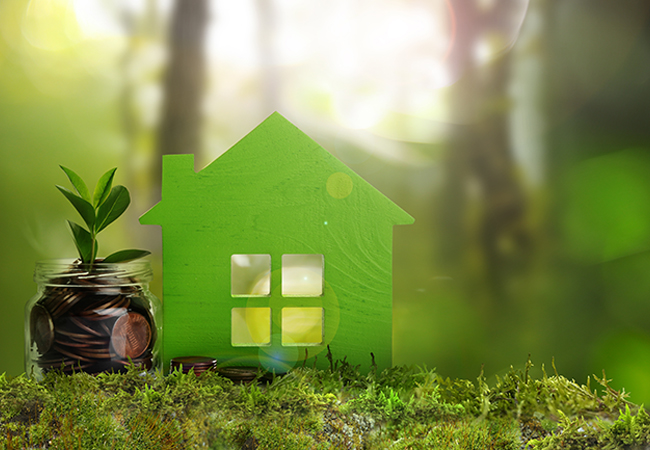
Eco friendly home. House model and jar with coins on green grass outdoors
In today’s world, where environmental consciousness is on the rise, adopting green living practices has become more important than ever. By reducing our carbon footprint, we can contribute to a healthier planet and create a more sustainable future for generations to come. You can learn more about lowering your carbon footprint at home by visiting https://happyeconews.com/6-ways-to-lower-your-carbon-footprint-at-home/. In this article, we’ll explore some simple yet effective steps to reduce your home’s carbon footprint and embrace a greener lifestyle. Green living is a lifestyle choice aimed at minimizing harm to the environment and conserving natural resources. It involves making conscious decisions to reduce waste, conserve energy, and embrace sustainable practices in everyday life. By taking small steps towards green living, individuals can play a significant role in mitigating climate change and preserving the planet’s ecosystems.
Understanding Carbon Footprint
Your carbon footprint refers to the total amount of greenhouse gases, particularly carbon dioxide, emitted into the atmosphere as a result of your activities. This includes emissions from transportation, energy consumption, waste generation, and more. Understanding your carbon footprint is the first step towards reducing it effectively.
Assessing Your Home’s Carbon Footprint
Conducting an energy audit is a great way to assess your home’s carbon footprint. This involves evaluating your energy consumption patterns, identifying areas of inefficiency, and finding opportunities for improvement. By pinpointing areas where energy is being wasted, you can take targeted actions to reduce your environmental impact.
Energy-Efficient Appliances
Investing in energy-efficient appliances is one of the most effective ways to reduce your home’s carbon footprint. Look for appliances with high Energy Star ratings, which indicate superior energy efficiency. When shopping for new appliances, consider factors such as energy consumption, water usage, and overall environmental impact.
Reducing Electricity Consumption
Simple habits like turning off lights and appliances when not in use can significantly reduce your electricity consumption. Additionally, maximizing natural light during the day and using fans instead of air conditioning can help lower your energy usage and decrease your carbon footprint.
Water Conservation Techniques
Conserving water is another essential aspect of green living. Fixing leaks and installing water-saving devices such as low-flow showerheads and faucet aerators can help reduce water waste. Additionally, being mindful of your water usage habits, such as taking shorter showers and only running the dishwasher when full, can make a big difference.
Green Transportation Options
Choosing sustainable transportation options can greatly reduce your carbon emissions. Whenever possible, opt for walking, biking, or carpooling instead of driving alone. If you need to use a car, consider investing in a fuel-efficient vehicle or exploring electric or hybrid options.
Waste Reduction and Recycling
Proper waste management is crucial for reducing your environmental impact. Practice recycling regularly and strive to minimize waste by choosing products with minimal packaging and avoiding single-use items whenever possible. Composting organic waste is another eco-friendly way to reduce landfill contributions and enrich soil health.
Embracing Sustainable Practices
Incorporating sustainable practices into your daily routine can have a significant impact on reducing your carbon footprint. Choose eco-friendly products made from renewable materials, and opt for reusable alternatives to disposable items. By making conscious consumption choices, you can minimize waste and support environmentally responsible businesses.
Green Landscaping
Transforming your outdoor space into a green oasis can contribute to a healthier environment. Planting trees and native plants not only enhances biodiversity but also helps sequester carbon dioxide from the atmosphere. Additionally, maintaining a sustainable garden with organic gardening practices reduces the need for harmful pesticides and fertilizers.
Eco-Friendly Home Renovations
If you’re planning home renovations or upgrades, consider incorporating eco-friendly features and materials. From energy-efficient windows and insulation to solar panels and green roofs, there are numerous ways to make your home more environmentally friendly. By prioritizing sustainability in your renovations, you can reduce your energy consumption and lower your carbon footprint.
Educating Family Members
Engaging your family members in green living practices is essential for creating lasting change. Teach children about the importance of environmental conservation and involve them in activities like recycling and gardening. By instilling eco-conscious values from a young age, you can empower future generations to make a positive impact on the planet.
Community Engagement
Joining local environmental initiatives and community groups is a great way to amplify your impact and connect with like-minded individuals. Participate in neighborhood clean-ups, tree planting events, and advocacy campaigns to promote sustainability in your community. By working together towards common goals, we can achieve greater collective progress towards a greener future.
Tracking Progress
Monitoring your progress towards reducing your carbon footprint is key to staying motivated and accountable. Keep track of your energy and water consumption, waste diversion efforts, and other sustainability metrics. Celebrate milestones and achievements along the way, and continue to seek out new opportunities for improvement.
Conclusion
Reducing your home’s carbon footprint doesn’t have to be daunting. By implementing simple yet effective green living practices, you can make a significant difference for the planet. From conserving energy and water to embracing sustainable transportation and waste reduction strategies, every small step counts towards building a more sustainable future for all.


